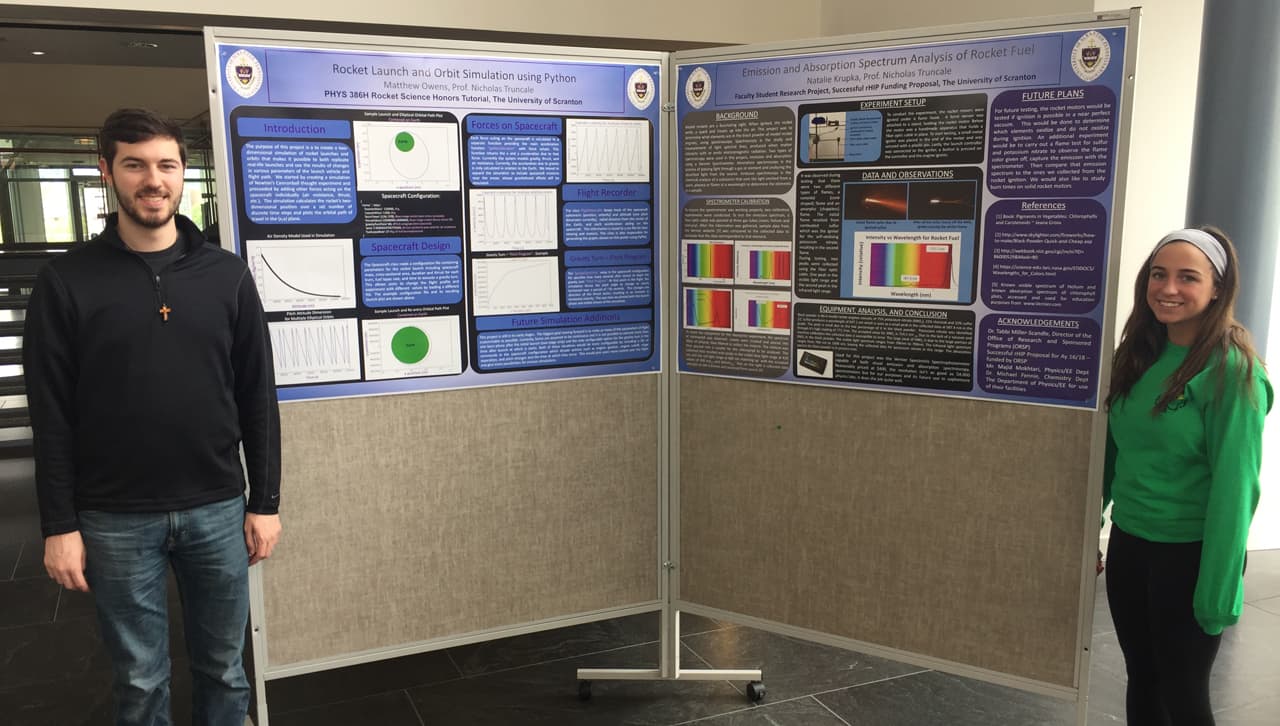Physics
Student Research
Natalie Krupka '20 Researches Rocket Fuel
To observe the emission and absorption spectrum of rocket fuel, we will be using a PASCO spectrometer in two ways: known light absorption spectrum
The spectrometer has an input, which allows one to place a liquid sample in a cuvette and measure the absorbed light of that substance. Light from a tungsten source passes through the samples in the cuvette and a high diffraction grating to detect the light that makes it through. Whatever light does not make it through, must be absorbed by that substance in the cuvette. This allows the production of the absorption spectra of the substance. The fiber optic cable captures light through a narrow slit and passed that light directly through a high diffraction grating allowing the spectrometer to show the emission spectrum of the source.
Using these two methods, I hope to be able to determine the elements in rocket fuel.
I liked knowing everyone in my field, knowing that I could ask anyone for help and they would be willing to, and I liked the teacher-student relationships that existed. I was able to work on three research projects during my time at Scranton because my teachers were willing to work with me.
Josh Zadoyko '18, Business Intelligence Consultant, SDG Group
 Natalie Krupka ’20, a physics major, researched rocket fuel. "To observe the emission and absorption spectrum of rocket fuel, we will be using a PASCO spectrometer in two ways: known light absorption spectrum
Natalie Krupka ’20, a physics major, researched rocket fuel. "To observe the emission and absorption spectrum of rocket fuel, we will be using a PASCO spectrometer in two ways: known light absorption spectrum Matthew Anzelmi '17 Presents Research
'Designing and Building a Watt Balance to find an Adjustment for Plank’s Constant'
Under the direction of Dr. Juan D. Serna, Matthew Anzelmi '17 researched "designing and building a watt balance to find an adjustment for plank's constant."
In his words: The watt balance is a relatively new instrument, which is currently being developed to redefine Planck's constant, and, in turn, redefine the kilogram in terms of the new fixed value of the constant. The scientists at the National Institute of Standards and Technology (NIST) have been designing and testing one of these balances for this purpose, and have measured Planck’s constant to 6 significant digits. The goal of this project was to design and build one of these balances based on various methods and designs previously implemented. Specifically chosen magnets and coil designs were used to optimize voltage and current output readings to reduce overall error normally present during the operation of these instruments.
The final product is meant to be designed in such a way that it is suitable for use in a modern physics laboratory setting, while also being cost-efficient enough to be built by any university student. Accompanying the balance, I wrote programs that assist the user with data acquisition and calibration control with an Arduino microcontroller.
Physics and Engineering Department
- Programs
- Program Curriculum
- Student Experiences
- Inside the Classroom
- Inside the Labs
- Department Newsletters
- Student Clubs
- Faculty/Contact Us
Physics
Undergraduate Admissions
Contact Us:
- Department
- Address 111
- Scranton, PA 18510
- The University of Scranton
- Phone: 570.941.xxxx
- Fax: 570-941-xxxx
- email@scranton.edu
Career Roadmap
The Center for Career Development is here to help you "map" out your path to success.
PhysicsLearn More







